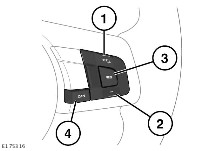
When the vehicle is stationary, press and hold the brake pedal to maintain control of the vehicle while using the SET+ button.
Light and gentle application of the accelerator pedal temporarily overrides the current set speed. When the accelerator pedal is fully released, the All Surface Progress Control (ASPC) system reverts back to the previously selected set speed.
Selecting very low speeds when pulling away on slippery surfaces can affect the vehicle's ability to make progress. For improved pulling away performance, it is recommended to select a set speed that is sufficient to maintain the vehicle's progress.
Light and gentle application of the brake pedal lowers the set speed in full function mode. When the brake pedal is fully released, the ASPC system maintains the speed at which the vehicle was travelling when the brake pedal was released. If the brake pedal is pressed when the ASPC system is active, a slight pulsation movement may be felt through the brake pedal.
When the ASPC system is enabled, the desired set speed for the vehicle can be set and adjusted. Use the control buttons mounted on the right side of the steering wheel.

Operate as follows:
RES should only be used if the driver is aware of the set speed and intends to return to it. Inappropriate use can potentially lead to vehicle damage or personal injury.
Pressing the CAN button retains the set speed for future use, unless the ASPC system or the ignition system is switched off.
The incremental increases or decreases of the set speed are influenced by the current set speed:
When the vehicle is travelling at speeds between 30 km/h (19 mph) and 80 km/h (50 mph), ASPC operation is suspended. The system enters stand-by mode and the instrument panel flashes the ASPC warning lamp. ASPC operation resumes when the vehicle's speed is less than 30 km/h (19 mph). If the vehicle’s speed exceeds 80 km/h (50 mph), the ASPC system disables and the ASPC warning lamp extinguishes. If required, ASPC has to be switched on again. See CONTRÔLE DE PROGRESSION TOUTES SURFACES (ASPC) (ORANGE).